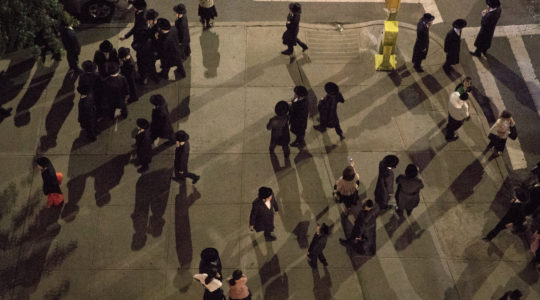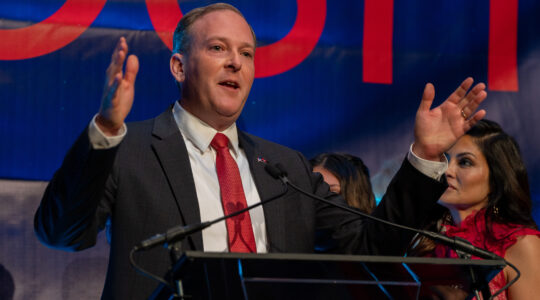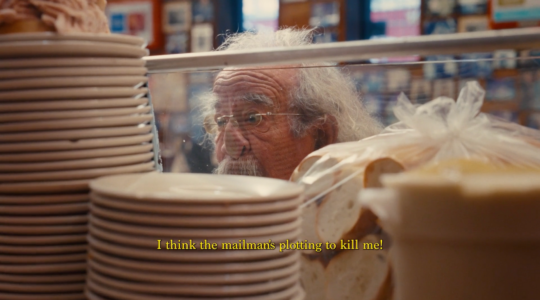One Yom Kippur day during my teen years in Annapolis, Md., just after the Musaf service, an elderly member approached me in the lobby of the synagogue.
She wanted to know how old the youngster was who had just joined his father and uncle for the first time in blessing the congregation with the Birchat Kohanim, the priestly benediction.
“He just had his bar mitzvah,” I told her.
“Is that so? Thirteen years old and already a Kohen,” she mused with astonishment and pride, not realizing that priestly status is granted by lineage rather than experience.
I smiled, reminded of the wide range of backgrounds among the 250 or so members of the community’s only congregation at the time. It included families connected to the U.S. Naval Academy, where military service was a sacred duty; professors who taught in Greek, Latin and Hebrew at nearby St. John’s College, where the unique curriculum has focused on The Great Books since 1696; a few Holocaust survivors who retained their faith after Auschwitz; and more than a few congregants, like the woman I spoke with that Yom Kippur day, whose observance was based more on ritual and rote than depth of Jewish knowledge.
Congregation Kneseth Israel was founded in 1906 as an Orthodox congregation, and proudly has maintained its traditions for more than a century. The fact that for most of those years it was the only synagogue in town meant that its members, the vast majority of whom did not follow Orthodox law in their personal lives, valued tradition and social unity over denominational rigidity.
A few would have preferred a higher mechitza separating the men and women in the sanctuary; most no doubt would have liked easing up on the full traditional service in Hebrew, and having more than a sprinkling of responsive readings in English. But everyone, whether they expressed it or not in words, felt the overriding importance of staying together as one congregation. It was the customs and history that kept them together, along with the rabbi who led them for almost four decades (from 1945 to his becoming rabbi emeritus in 1983, two years before his death). That rabbi was my dad, Morris D. Rosenblatt, and while his manner was mild and soft-spoken, his commitment to Jewish tradition was firm. And somehow he and my mom, the consummate rebbetzin, and the dedicated cantor and leadership of the shul over the years, helped keep Kneseth Israel a cohesive congregation.
It’s clear to me that growing up in a small town with one synagogue, where people managed to stay together despite their differences, continues to inform my views on Jewish community.
New York represents the other extreme of the Annapolis experience. It is such a large community — really many hundreds of communities — that each group has its own critical mass and really isn’t dependent on the others. You don’t like the way decisions are made in your synagogue? Try the one down the block. You think the rabbi wasn’t friendly to you last Shabbat? Start a petition to cancel his contract.
Why try to talk things out, hear the other guy’s view or compromise, when you have so many options?
That’s not to say that practicing a traditional Jewish life in a small town was easy. It was lonely being one of a handful of observant youngsters in the community, attending a public elementary school where The Lord’s Prayer was recited each morning and needing permission to be excused from the Christmas caroling each December.
For my dad, rounding up a minyan every day was always a worry, and there was a shortage of religious resources, from kosher butchers to qualified Hebrew school teachers.
Support the New York Jewish Week
Our nonprofit newsroom depends on readers like you. Make a donation now to support independent Jewish journalism in New York.
The longtime and beloved teacher at the synagogue’s kindergarten was not Jewish, which made teaching her charges the blessings over various food groups a challenge — for us as well as for her. Several generations of Annapolis kids grew up pronouncing “baruch” as “bar-rootch.” I am sure that some of the questions put to my dad about religious practice would never be encountered by rabbis in large Jewish communities, like the woman who wanted to know if salting a chicken she bought at the Safeway would make it kosher, or the fellow who had to work on Saturdays but explained that he did not turn on lights or answer the phone on Tuesdays, his personally designated Shabbat.
To me, though, it is the small-town rabbis who are the unsung heroes of American Jewish life. They operate in the trenches, dealing with day-to-day issues of faith and practice, part role model and part next-door neighbor, seeking to ensure Jewish survival against sometimes overwhelming odds. Assimilation rates were high in Annapolis, but individual triumphs were especially sweet. There was a young couple, students at St. Johns College, who fell in love. She was not Jewish, and his parents, Holocaust survivors, opposed the match. But she studied diligently with my dad and converted, led a religious life and saw her son become an Orthodox rabbi.
And there were a number of less dramatic but significant stories of families becoming more observant, others experiencing Israel in a meaningful way or leading fundraising efforts for Jewish causes.
Walking down Main Street as a youngster, I would often be stopped by people who recognized me for my family connection. “Isn’t your father the Jewish rabbi?” they would ask. (“As opposed to the non-Jewish rabbi?” I thought but never asked.)
It was a reassuring to feel part of a community where people looked out for each other. Like the day I got my driver’s license, at 16. On my first solo spin around town I was pulled over by a cop who demanded to see my license, which was barely dry. Terrified, I wondered what infraction I’d committed while giving hand signals (remember those?) before each turn and crawling along well under the speed limit.
“Isn’t this Rabbi Rosenblatt’s car?” he challenged in a firm voice. “I’ve never seen you driving it.”
I realized he was looking out for my dad, and thought some kid had stolen the rabbi’s car, out for a joy ride — albeit at 15 mph. When I explained that I was the rabbi’s son and just got my license, his whole demeanor softened and he wished me a great day. “And say hi to the rabbi,” he said in parting.
Since becoming an adult and moving away, I’ve belonged to much larger congregations, and deeply appreciate the benefits for my family and me in having so many observant friends in the neighborhood, and an environment where it is so easy to practice one’s faith openly.
But Annapolis and Kneseth Israel will always be home for me. And while I may know more people these days in the shul cemetery than at Shabbat services, I take pride in seeing the synagogue, with its dedicated rabbi, still active. And it’s a comfort to know that my parents’ tireless efforts for all those years not only are remembered and appreciated, but are part of the fabric of the congregation itself.
May it thrive for another 100 years.
The New York Jewish Week brings you the stories behind the headlines, keeping you connected to Jewish life in New York. Help sustain the reporting you trust by donating today.




